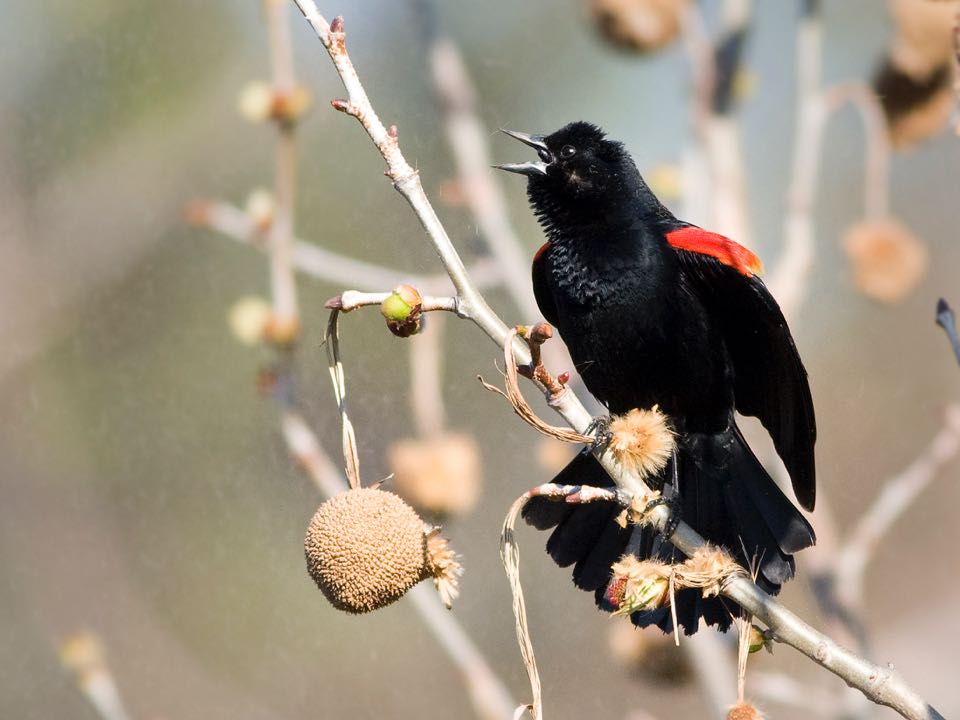By Ashley Peele

Red-winged Blackbird at Richmond Rookery (Bob Schamerhorn)
Despite the recent snows, birds are singing and spring is in the air! As thoughts turn towards this year’s Atlas activities, some volunteers may be pondering over their Atlas blocks. Perhaps, wondering if it is time to move on to a new area. If you’re one of those volunteers, then this is the article for you! Over the past winter season, the VABBA2 project has undertaken a major review of the 2016-2017 Atlas dataset to assess what blocks have or will soon be completed. Based on this assessment, we have updated our block completion guidelines to provide greater clarity for our volunteers.
Please note that the project published a post with detailed guidance on block completion last summer, but though much of that guidance remains unchanged, please use the guidelines below from here on out to assess whether your block is complete. You will also receive notification from your regional coordinator when it is time to move on to a new block.
Block Completion Guidelines:
- Survey effort in a given block should total a minimum of 20 diurnal hours, spread over multiple visits. These visits should be distributed throughout the breeding season (guideline 2).
- Note! If you (or others also working on a given block) have logged 40+ hours of effort in a single block, move on to a new priority block.
- Survey visits should be spread throughout the breeding season.
- Most of your effort to document breeding evidence should focus on the peak breeding season from May through mid-July, when you should get the most ‘reward’, i.e. obvious breeding behavior, for your time. BUT, surveying outside of this main window is also important.
- Early or late breeders may be missed if blocks are ONLY visited in May-July, so try to fit in a March and August visit as well.
- All habitat types that are present within a given block should be visited (if accessible). Surveying every inch of a block isn’t realistic but doing your best to visit every habitat type is.
- Note! We understand that accessibility is often a challenge, so let your regional coordinator know if you just aren’t going to be able to access an area. For example, if your block has one wetland on private lands and you have not been granted access, then go ahead and move on to a new area.
- Please plan on visiting a minimum of four different sites for surveying any given block, even if your block only has two or three habitat types present.
- At least 60% of species detected are coded as Probable and/or Confirmed breeders. This is the biggest update to our block completion policies. The original guideline asked for 50% of species to be confirmed as breeders and we have now decided to also include the # of probable breeders into this guideline but raise the species threshold.
- Based on analysis of current and past Atlas data, this new metric should allow you to more easily complete a block and will hopefully avoid excess disturbance to nesting areas.
- Thus far, our volunteers have done a great job of avoiding excess disturbance to birds during the nesting season and we’d like for this to continue throughout the project.
- At least two nighttime (or pre-dawn) visits, totaling 2-4 hours of nocturnal effort, are conducted per block.
- Lastly, while we still encourage volunteers to use the VABBA1 data as a useful resource for assessing what species were present historically, many blocks had low effort or have changed significantly since the last Atlas was conducted in the late 1980s. Therefore, we recommend volunteers focus primarily on the first five criteria listed above.
The following are summary statistics for block completion from the 2016-2017 data review and analysis:
- 57 completed VA Atlas blocks – 25 priority/32 non-priority
- 121 blocks – need only nocturnal effort to be completed
- 158 blocks – need nocturnal effort AND more species upgraded from possible to probable or confirmed breeding status, but are otherwise close to completion
Volunteers can check the completion status of any Atlas block by using the ‘Explore a Region’ tool in the project eBird portal (https://ebird.org/atlasva/home). If your block is not complete and you have questions about why, then please review the guidelines above first. If still unsure, then please contact your regional coordinator. Regional coordinator contact info can be found under the Contacts page of the VABBA2 website (www.vabba2.org).
A big thanks to those of you who have completed or are working towards completing Atlas blocks. Many VABBA2 blocks are ‘close’ to completion, so volunteers who focus on finishing up these blocks can make a huge impact for the project during our 2018 field season. For those of you who have completed one or more blocks, please shift your survey effort to a priority block that currently has little or no effort in your region. This will be of the greatest benefit to the project.
~ Dr. Ashley Peele, State Coordinator, VA Breeding Bird Atlas Project


